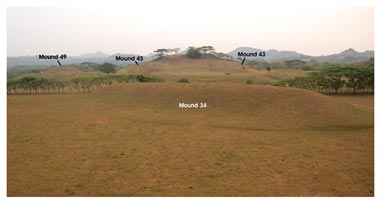
| FAMSI © 2008: Wesley D. Stoner |
||
Tepango Valley Archaeological Survey: Tuxtla Mountains, Southern Veracruz, México
Research Year: 2007 Table of Contents
Abstract The Tepango Valley Archaeological Survey (TVAS) was undertaken of 120 km2 within the Tepango River valley in the Tuxtla Mountains, southern Veracruz, México to gain an understanding of the occupational history of this important area. Data are used to retrodict the political organization of the Tepango Valley during every major epoch of pre-Columbian occupation. These data are then briefly compared to settlement in the neighboring Catemaco River valley. While materials and settlement analyses are still underway, this report comes to the conclusion that El Picayo (the primary center within the Tepango Valley), Matacapan (the primary center within the Catemaco Valley), and their corresponding hinterlands evolved simultaneously into relatively equal, but distinct, political entities. However, political authority within each valley appears to have been based on different themes. This has implications for the evolution of both valleys, particularly the role of Teotihuacán in the development of the Matacapan and the Catemaco Valley. El Recorrido Arqueológico del Valle Tepango (RAVT) fue hecho de 120 km2 dentro del valle del Río Tepango en la Sierra de los Tuxtlas, al sur de Veracruz, México a ganar una comprensión de la historia de asentamiento. Los datos son utilizados a deducir la organización política del Valle Tepango durante cada época de la ocupación pre-Colombina. Estos datos son comparados brevemente al asentamiento en el valle vecino del Río Catemaco. Los análisis de materiales y asentamientos son todavía en camino, pero este informe llega a la conclusión que El Picayo (el centro principal dentro el Valle Tepango), Matacapan (el centro principal dentro el Valle Catemaco), y sus interiores correspondientes evolucionados simultáneamente en entidades políticas relativamente iguales pero distintas. Sin embargo, la autoridad política dentro de cada valle aparece haber sido basada en temas diferentes. Esto tiene implicaciones para la evolución de ambos valles, especialmente el papel de Teotihuacan en el desarrollo del Matacapan y el Valle Catemaco. Click to download the report in PDF format: Tepango Valley Archaeological Survey: Tuxtla Mountains, Southern Veracruz, México The PDF files require Adobe Acrobat Reader.
Submitted 12/27/2007 by: |
||
|
Text links to all pages at this site are available at the FAMSI INDEX |
||

